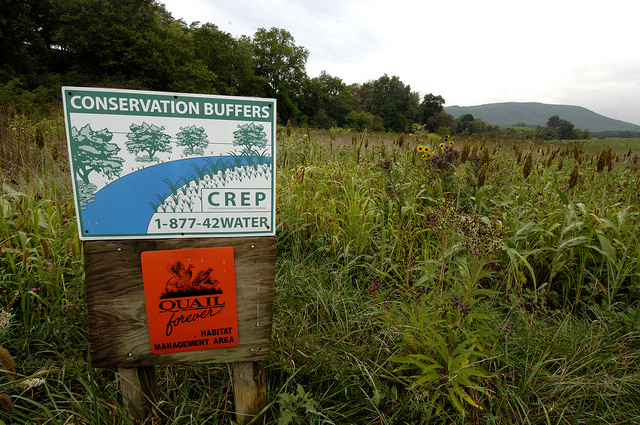Bridging the public-private land divide for conservation
Land-sharing
by Liza Lester, ESA communications officer

The U.S. Department of Agriculture (USDA) Natural Resource Conservation Service (NRCS) works with local farmers as part of the Chesapeake Bay Watershed Initiative (CBWI). CBWI is voluntarily program that farmers, ranchers and forestland owners install conservation practices on hundreds of thousands of acres annually to help support rural economies, protect wildlife habitat and improve water quality in the Chesapeake Bay Watershed in Tidewater County, Virginia on September 9, 2008. This is a conservation buffer zone for a quail habitat. Conservation buffers are areas or strips of permanent vegetation established in and around row crops. They include filter strips, riparian buffers, field borders, shallow water areas for wildlife, grassed waterways, field windbreaks, shelterbelts, designated wellhead protection areas, living snow fences, and contour grass strips. Buffer zones are designed to intercept sediment and nutrients, reduce soil erosion, enhance air and water quality and fish, and wildlife habitats, which encourages biodiversity and beautifies agricultural landscapes. USDA photo by Bob Nichols.
For much of the world, high-intensity industrial farming produces food with high efficiency, but puts the squeeze on other plant and animal life. Wildlife is mostly sequestered on preserves. But is this the best way to maximize food and biodiversity? Or are there other configurations that might improve mobility of wildlife and benefit other ecosystem services without cost (and possibly with benefit) to private land owners?
Agriculture alters the landscape more than any other human activity, with trickle-down effects on water, soil, climate, plant and wildlife diversity, wildfire, and human health. Crop and rangeland occupies nearly 40 percent of earth’s ice-free land, and mountains and deserts make much of the remaining surface unwelcoming to agriculture. Our increasing population applies constant pressure for further conversion of wild lands to agricultural production. With yields plateauing in many parts of the world, managers, both private and public, are looking for new ideas to get the most out of agricultural lands, sustain production into the future, and protect natural resources.
Quite a few sessions will address the ecological study of agricultural systems at the Ecological Society of America’s 98th Annual Meeting, coming up soon in Minneapolis, Minnesota, August 4 – 9. The organized oral session “Bridging the public-private land divide” takes on collaboration between conservation scientists and ranchers, farmers, and other land owners, look for, as the organizers put it, “opportunities for collective action.”
“We are probably not going to be able to achieve landscape conservation goals for soil, water, and wildlife, specifically grasslands and birds, working on publicly-owned lands alone. We will need to incorporate private lands,” said session moderator Chris Woodson, a private lands biologist with the U.S. Fish and Wildlife Service in Missouri.
Conservation biologists are looking for conservation-supportive practices that have potential to augment protected areas on public lands and aid existing programs. Private landowners and entrepreneurs are looking for contributions that they can make to conservation and still make a living.
“Lower case c conservation is what we want to see happen,” said session co-organizer Paul Charland, a wildland firefighter with the U. S. Fish and Wildlife Service. “Capital C Conservation is official business; it’s the movement as an organizational process. Lower case conservation is all efforts to keep native species. We want to provide a mechanism for everyone to do that.”
 Organized Oral Session 23: Bridging The Public-Private Land Divide – Supporting Biodiversity Conservation and Ecosystem Services By Tapping The Ingenuity In Social-Ecological Systems.
Organized Oral Session 23: Bridging The Public-Private Land Divide – Supporting Biodiversity Conservation and Ecosystem Services By Tapping The Ingenuity In Social-Ecological Systems.
Thursday, August 8, 2013: 8:00 AM-11:30 AM, room 101A
Organizers: Patrica Heglund; Paul Charland; Carol Williams;
Moderator: Chris Woodson
Resilient future
Two sessions of brave “Ignite” volunteers will offer 5-minute introductions (with slides auto-advancing every 30 seconds) to their ideas for the future interdependency of conservation and agriculture, from plant breeding and field design, to farm policy.
- IGN 1: Realizing a Resilient Food System
Tuesday, August 6, 2013: 8:00 AM-10:00 AM.
Organizer: Meagan E. Schipanski - IGN 5: Complementarity Considers Ecological Principles to Create Sustainable Pathways
Tuesday, August 6, 2013: 1:30 PM-3:30 PM.
Organizers: Shelby Williams and Clarence L. Lehman